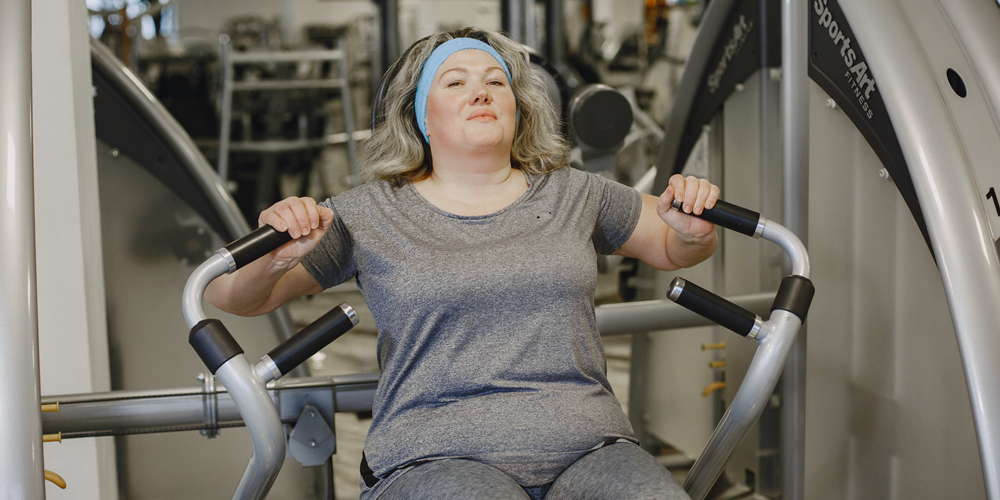Maintain Your Muscle

Strength Training at Any Age
You’ve likely heard that exercise can help you live a longer, healthier life. When you hear the word ‘exercise,’ you might think of going for a run or hopping on a bicycle. Or maybe playing soccer with your kids or basketball with your friends after work. But these activities don’t include all the types of movements that are important for your health.
The examples above are endurance exercise. Also called cardiovascular exercise, activities like these increase your breathing and heart rate. They can keep your heart and lungs in good shape and help prevent many chronic diseases. But exercises to maintain flexibility, balance, and strength are also important.
Stretching gives you more freedom of movement and makes daily activities more comfortable. Balance practice helps prevent falls, which become a concern as you get older.
Strength training, also called resistance training or weight training, is particularly important. It brings many benefits. First, it makes your muscles stronger. That can help you keep up the activities you enjoy—at any stage of your life.
It’s not about getting big muscles, explains Dr. Wendy Kohrt, an aging expert at the University of Colorado. In fact, most people who do strength training don’t see much of a change in muscle size.
But at all stages of life, she says, “maintaining muscle mass and muscle function is really important for quality of life.”
Start Building Muscle Safely
Scroll through the images below for tips on getting started with resistance training.
Building Up Benefits
Building muscle can do more than make you stronger. Some types of strength training keep your bones healthy, too. Strength training can also improve the way your body processes food to help prevent diabetes and related diseases.
“And like endurance activity, regular strength training is associated with lower risk of cardiovascular disease and other chronic diseases,” says Dr. Joseph Ciccolo, an exercise researcher at Columbia University.
But the main benefit of strength training, as the name suggests, is that it makes your muscle cells stronger. “That benefit is unique to strength training,” says Dr. Roger Fielding, who studies the benefits of exercise at Tufts University.
Experts recommend that children and teens do muscle-strengthening activities at least three days a week. For adults, they encourage strength training for the major muscle groups on two or more days a week.
The benefits of strength training increase as you get older, says Fielding. Maintaining strength is essential for healthy aging.
“Loss of muscle with aging can limit people’s ability to function in their home environment and live independently,” Kohrt says. “Just being able to get up out of a chair or go up and down stairs requires a fair amount of muscle strength.”
In a recent study, Fielding and other researchers tested a three-month weight-lifting program in older adults who already had difficulty walking. At the end of the study, participants who lifted weights improved at tasks like repeatedly bending their knees. Such movements are essential for activities of daily living. In contrast, study participants who only stretched at home did not see similar improvements in strength.
“As we age, I think it’s even more important to consider incorporating some strength training into our physical activity routines,” says Fielding. “We can either slow down the progression of age-related muscle loss or prevent it.”
Getting Started
If you want to get started with strengthening exercises, what should you do? Strength training may seem intimidating if you’ve never tried it.
“People naturally learn to walk as part of growing up. But you don’t necessarily learn how to lift weights,” Ciccolo says.
If it’s feasible for you, booking a few sessions with a personal trainer is a good way to get started, says Kohrt. “That can get you introduced to the types of exercises you could do,” she explains.
There are also many low- or no-cost classes available. Look for them at local gyms, recreation centers, senior centers, and community centers.
Like with any new activity, to make strength training stick, “you have to find something that you really like to do,” says Fielding. “Some people will want to exercise in a group, in a community setting. Others will be happy doing all their exercises in their home, by themselves.”
If you’ve never lifted weights before, talk with your health care provider before you start any home-based strength training routine.
Whatever you choose to do, “start slowly and build up very gradually,” says Kohrt.
Source: NIH News in Health, March 2020
Independence for Older and Disabled Adults

In July we celebrate liberty and justice for all. Sadly, as we age well intentioned fellow Americans often chose to curtail older or disabled Americans’ inalienable rights.
Overprotection may appear on the surface to be kind, but it can be really evil. An oversupply can smother people emotionally, squeeze the life out of their hopes and expectations, and strip them of their dignity.
Robert Perske
Is there such a thing as too much protection? Yes! Older and disabled adults deserve the right to make decisions about their own life that could expose them to potential harm. It is called dignity of risk, and it is an essential human right. The term, dignity of risk, was first coined in 1972 by Robert Perske in reaction to over-protective safeguards and a paternalistic manner by direct care staff toward elders in institutional settings, which he argued, was patronizing and diminished a person’s freedoms and self-esteem.
Today the term dignity of risk refers to the concept of affording a person the right (or dignity) to take reasonable risks, and that the impeding of this right can suffocate personal growth, self-esteem and the overall quality of life (Ibrahim & Davis 2013).
Yet even today well-intentioned relatives and caregivers are stripping away older and disabled Idahoan’s civil and legal rights, self-esteem, and quality of life by pursuing guardianship with the motivation to keep their older loved ones safe. Although we applaud the motivation, the Idaho Commission on Aging advocates for older and disabled adults by urging concerned caregivers to consider the multitude of alternatives to guardianship for as long as possible.
What are alternatives to guardianship? Some examples include:
- Representative payee
- Durable powers of attorney
- Health care surrogacy
- Living wills
- Trusts
- Community advocacy systems
- Joint checking accounts
- Case management
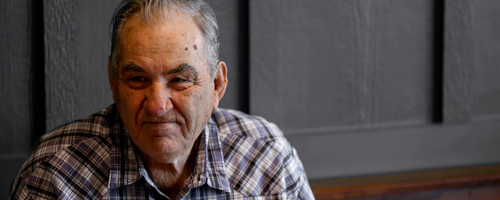
Power of Attorney
A power of attorney is a legal document. The document grants one person, generally called an agent, sometimes known as an attorney in fact, the authority to act on behalf of the person appointing them. The person appointing the agent is called the grantor. To create a power of attorney, an adult must be able to understand they are appointing the agent and understand the kinds of authority they are giving the agent. The scope of the agent’s authority is limited by the terms of the document and by state laws. A grantor with capacity can revoke or modify the appointment of an agent in a power of attorney. Revocation of a power of attorney should be in writing, signed by the grantor, with a copy delivered to the agent and anyone who is likely to be dealing with the agent. In some states, the revocation needs to be recorded in the public records like a deed. A power of attorney is a private agreement and is not subject to automatic oversight by the Courts.
Social Security Representative Payee
A Social Security Representative Payee (rep payee) receives the benefits for a beneficiary who has been determined unable to manage money by the Social Security Administration (SSA). Rep payee is specific to Social Security benefits, including Social Security Disability and Supplemental Security Income (SSI). VA pensions and some private pensions have separate payee systems. Social Security will place the benefits in payee status if SSA has reason to believe that the beneficiary is unable to manage benefits. The evidence is either a verification from a physician who has seen the person recently, or evidence in a disability case of serious mental illness or substance abuse. The beneficiary can file voluntarily if they are unable to manage their benefits. The process is entirely administrative. Social Security does not recognize any other agents. Guardians and agents under powers of attorney must apply to Social Security to be recognized as a representative payee.
Someone seeking to be appointed as a rep payee should contact Social Security with the name and identifying information for the beneficiary, the reason the person needs a payee, and name and contact information of a physician who has recently seen the person and may include a proposed payee. Social Security then sends notice to the beneficiary, and a verification form to the physician. The beneficiary has a right to object to the need for a payee, or to the proposed payee. Upon finding of need for a rep payee, Social Security does a basic background check on the proposed payee. The payments must be directly deposited into a separate account, titled “payee as representative payee” for the benefit of the named beneficiary. Most payees file a very basic annual accounting. Representative Payee status can be terminated, at request of the beneficiary, with proof that the beneficiary has regained the ability to manage benefits. If the payee resigns or becomes unable to serve, benefits are held until a replacement payee can be appointed. There is a shortage of reliable volunteer payees and a need for representative payees. All payees are volunteers, with an exception for narrowly defined non-profits who are allowed to receive a limited fee from the benefits. In some states, inpatient residential settings, such as nursing homes, are allowed by state law or regulation to serve as representative payees.

Health Care Surrogate
A health care surrogate is a person who makes health care decisions for a person, when the person lacks capacity to make health care decisions. This person may also be called a health care agent or proxy. In every state, a person with capacity can appoint a health care surrogate in a durable power of attorney that incudes health care authority. Many states have a short form for naming a health care surrogate. A person has capacity to appoint a health care surrogate if they understand what a health care decision is and can name a person they trust to make health care decisions. If a person does not appoint someone, 45 state statutes give guidance on who can make health care decisions. Generally, statutes turn to the nearest relatives to make health care decisions. Health care decision-making is the only area of decision-making where the law creates a default agent when a person does not name an agent in writing.
The authority of a health care surrogate to make health care decisions does not start until the person loses capacity, or knowingly defers to the agent. The determination of loss of capacity is made by the person’s health care providers. The criteria and documentation for the loss of capacity is based on state law. The scope of the authority is defined in the document and by state law. If the person has capacity, the person can revoke or modify the appointment of a surrogate. Many states have a very low standard of capacity for revocation of an advance directive. Aside from leaving directions on who can make health care decisions, many people leave directions about the health care they want or do not want in the form of an advance directive or living will directive. When making health care decisions for another person, it is helpful to understand their health care values, goals of care, and specific wishes.

Bank Accounts
A common way to manage another person’s finances is to authorize an agent to sign on to that person’s bank accounts. There are two ways to do this: 1) add a person authorized to transact business on the account; or 2) make the bank account a joint account. A joint account creates a presumption of ownership in the account assets and may create inheritance rights. Joint accounts are very helpful for married or committed couples. For more distant family members or friends, joint accounts should be used with great caution. Rather than create a joint account, the bank can authorize someone to sign on the account without creating an ownership interest in the account.
This is commonly accomplished by the bank recognizing the authority granted under a power of attorney. In many states, the banks may insist on a state standard form, or a bank approved power of attorney form. Banks can also authorize signers on accounts without creating an ownership interest; many business accounts are structured this way. Direct deposit and automatic payment for All Social Security benefits and virtually all retirement benefits are paid by direct deposit. Direct deposit eliminates the need to make deposits and prevents lost or stolen checks. Nearly all reoccurring bills can be set up on automatic payment. The combination of direct deposit and automatic payments can help to assure that necessary bills are paid when a person is unable to attend to finances. These arrangements should be monitored to assure that all income is properly received, and automatic payments are correct. Increasingly, financial institutions and utility providers are willing to send copies of invoices and statements to a third party, or to arrange online access for accounts oversight.
This information was supported by a contract with the National Center on Law & Elder Rights, contract number HHSP233201650076A, from the U.S. Administration for Community Living, Department of Health and Human Services, Washington, D.C. 20201
Additional resources to help concerned family and caregivers support their older relatives without the civil death of full guardianship are:
- A Guide to Managing Someone Else’s Money
- Alternatives to Guardianship and Conservatorship for Adults (explains supported decision making)
- What Caregivers Should Know About Managing a Loved One’s Money (a guide from AARP)
Thank you for standing up for life, liberty, and the pursuit of happiness for older Idahoans! Visit the ICOA website for additional information and services to help older Idahoan’s age with safety and dignity.
Resident’s Rights: What to Expect

When a loved one no longer is able to remain at home safely with supports it pays to have some basic knowledge when faced with the task of finding appropriate placement. Long-Term Care is a system unto itself with a language that most do not know if they have not had experience with either Skilled Nursing care or Assisted Livings facilities.
Take the time to explore options available for your loved one and take the time to personally visit facilities in the area that you would like your loved one to reside.
When you visit your facility options observe:
- The feeling of entering into the facility
- Smell or odors
- Volume of music, laughter, staff communications, other sounds
- Staff interactions with residents
- A meal when possible
Are:
- You greeted and welcomed by a staff
- Conversations with administration focused on financial rather than on resident care.
And visit during the weekend to observe staffing and the facility environment
The big Question is– are staff “Resident Centered”?
Types of Long -Term Care-
Skilled nursing care requires a skilled medical need for services to be authorized for insurance coverage. If the resident has Medicare it pays for the first 20 days and then the resident is required to private pay for the room and board for up to the next 100 days if there is no other payment source. For Medicare to cover, the individual must have a 3 day stay in the hospital. Medicare will not cover if the individual was admitted to the hospital for observation rather than treatment.
When an individual does not have a medical need for placement and is in need of long-term care services that is beyond assisted living care, options for payment may be long term care insurance, private pay or Medicaid.
The person Centered Care Plan in skilled Nursing Care or long term care guides the care that an individual has been assessed to need for their best quality of life.
Assisted Living level care is not a skilled level of care. According to Idaho Licensing and Certification “A Residential Assisted Living Facility is a facility or residence operated on either a profit or nonprofit basis for the purpose of providing necessary supervision, personal assistance, meals, and lodging to three or more adults”.
In an Assisted Living facility, the Negotiated Service Agreement guides the level of care required to meet the residents needs and increase or maintain their quality of life.
Residents and resident representative should have a voice in the development of these care plans.
Prior to signing an admission agreement—read the entire agreement and do not sign until you have read and understand what you are agreeing to. At a later time should you have questions or concerns it may be dependent upon what was in the admission agreement as to what rights you may have going forward. Keep a copy of the Admission Agreement that was signed upon admission.
Nationally staffing is at critical levels due to shortages. There has never been a more important time to be aware and involved in the long-term care of a loved one.
Know your rights. Every facility is required to post residents rights. When you have concerns or questions related to resident care contact your local Area Agency on Aging Long-Term Care Ombudsmen they are a great resource for information and resident advocacy.
Know who your advocates are and how to contact them- Ombudsmen are formally trained advocates that can help when family efforts aren’t enough.
Visit the ICOA website for additional information and services to help older Idahoan’s age with safety and dignity. www.aging.idaho.gov
Prevent Burnout
25 Ways to Improve Your Day
Simple self-care strategies to help you feel better
- Put things into perspective [What is truly important?]
- Take a quick walk
- Laugh at something silly
- Do a random act of kindness
- List three things that make you smile
- Take a power nap [less than 20 min]
- Drink water
- Call or text a friend
- Check your posture and readjust
- Unplug
- Listen to calming music
- Change up your environment
- Take three deep breaths
- Get some fresh air
- Eat a balanced meal or snack [focus on protein and produce]
- Do just one thing at a time
- Draw, doodle, or create something
- Tell yourself you’re doing a good job
- Take a break
- Stretch your body
- Write down what is frustrating you and/or causing you stress
- Pet a dog or cat
- Ask for help
- Set a boundary
- Organize or tide up something [a drawer, a file, your desk, etc.]
Communication and Alzheimer’s

Alzheimer’s disease and other dementias gradually diminish a person’s ability to communicate. Communication with a person with Alzheimer’s requires patience, understanding and good listening skills. The strategies below can help both you and the person with dementia understand each other better.
- Changes in communication
- Communication in the early stage
- Communication in the middle stage
- Communication in the late stage
Additionally, the Idaho Commission on Aging website has Dementia Skills training that focuses on preparing and promoting communication and providing safe and comfortable care. See https://aging.idaho.gov/stay-educated/dementia-skills/.
Changes in the ability to communicate can vary and are based on the person and where he or she is in the disease process. Problems you can expect to see throughout the progression of the disease include:
- Difficulty finding the right words
- Using familiar words repeatedly
- Describing familiar objects rather than calling them by name
- Easily losing a train of thought
- Difficulty organizing words logically
- Reverting to speaking a native language
- Speaking less often
- Relying on gestures more than speaking
Communication in the early stage
In the early stage of Alzheimer’s disease, sometimes referred to as mild Alzheimer’s in a medical context, an individual is still able to participate in meaningful conversation and engage in social activities. However, he or she may repeat stories, feel overwhelmed by excessive stimulation, or have difficulty finding the right word. Tips for successful communication:
- Don’t make assumptions about a person’s ability to communicate because of an Alzheimer’s diagnosis. The disease affects each person differently.
- Don’t exclude the person with the disease from conversations.
- Speak directly to the person rather than to his or her caregiver or companion.
- Take time to listen to the person express his or her thoughts, feelings and needs.
- Give the person time to respond. Don’t interrupt unless help is requested.
- Ask what the person is still comfortable doing and what he or she may need help with.
- Discuss which method of communication is most comfortable. This could include face-to-face conversation, email or phone calls.
- It’s OK to laugh. Sometimes humor lightens the mood and makes communication easier.
- Don’t pull away; your honesty, friendship and support are important to the person.
Communication in the middle stage
The middle stage of Alzheimer’s, sometimes referred to as moderate Alzheimer’s, is typically the longest and can last for many years. As the disease progresses, the person will have greater difficulty communicating and will require more direct care. Tips for successful communication:
- Engage the person in one-on-one conversation in a quiet space that has minimal distractions.
- Speak slowly and clearly.
- Maintain eye contact. It shows you care about what he or she is saying.
- Give the person plenty of time to respond so he or she can think about what to say.
- Be patient and offer reassurance. It may encourage the person to explain his or her thoughts.
- Ask one question at a time.
- Ask yes or no questions. For example, “Would you like some coffee?” rather than “What would you like to drink?”
- Avoid criticizing or correcting. Instead, listen and try to find the meaning in what the person says. Repeat what was said to clarify.
- Avoid arguing. If the person says something you don’t agree with, let it be.
- Offer clear, step-by-step instructions for tasks. Lengthy requests may be overwhelming.
- Give visual cues. Demonstrate a task to encourage participation.
- Written notes can be helpful when spoken words seem confusing.
Communication in the late stage
The late stage of Alzheimer’s disease, sometimes referred to as severe Alzheimer’s, may last from several weeks to several years. As the disease advances, the person with Alzheimer’s may rely on nonverbal communication, such as facial expressions or vocal sounds. Around-the-clock care is usually required in this stage. Tips for successful communication:
- Approach the person from the front and identify yourself.
- Encourage nonverbal communication. If you don’t understand what the person is trying to say, ask him or her to point or gesture.
- Use touch, sights, sounds, smells, and tastes as a form of communication with the person.
- Consider the feelings behind words or sounds. Sometimes the emotions being expressed are more important than what’s being said.
- Treat the person with dignity and respect. Avoid talking down to the person or as if he or she isn’t there.
- It’s OK if you don’t know what to say; your presence and friendship are most important.
Please see Idaho Commission on Aging website https://aging.idaho.gov/caregiver/ for additional education and training, schedule of local events in our community and Area Agencies on Aging contact information.
Resource: alz.org/help-support/caregiving/daily-care/communications
Family Caregivers: A Resource Worth Guarding

Family caregivers manage emergencies, juggle priorities, and suffer isolation – and that was before unprecedented challenges of the COVID19 pandemic. It is estimated that 1 in 4 Idahoans is a caregiver, providing 171 million hours of unpaid labor to the state annually (AARP, 2017). This month we will share resources and creative ideas developed by Idaho community respite providers designed to assist caregivers to take necessary small breaks or virtual support during the pandemic.
Once the pandemic became reality many of our community respite providers had to develop safe and creative ways of aiding caregivers and their families.
Short Breaks Prevent Long Term Problems
Click on each organization’s name to be re-directed to their website for more information.
Hike 2 Heal (H2H) provides short-term relief from the physical, emotional, and daily demands of caring. H2H initiated virtual hiking throughout the summer with caregivers, the activity encouraged caregivers to continue hiking and tracking miles. They also developed a “Virtual Care Package” with a mix of quality entertainment, fun recipes, scenic drives, trail maps and other activities.
Family Caregiver Navigation Pilot is a project of the Idaho Caregiver Alliance (ICA), offering free telephone based support and resource referral to family caregivers in SW Idaho. Adults in SW Idaho who provide unpaid care for another individual of any age, with physical, intellectual, or cognitive disabilities, or a mental health condition qualify for the service. Call 208-426-5899 to connect with a Navigator.
Legacy Corps at Jannus, Inc changes lives through caring volunteers and a portfolio of diverse programs that promote health, advance policy, and create opportunity. Respite volunteers provided weekly phone support to caregivers providing up to date and accurate information and resources specific to their caregiving situation. Volunteers delivered groceries, household, and COVID-19 protective supplies to homes, and helped families set up online and/or phone ordering/delivery systems. Virtual respite based on individual circumstances included phone/Facetime conversations with recipients, through the window visits and park meet-ups.
Relatives as Parents, Inc (RAP) provides supportive services and support groups to relative caregivers of absent parents in Coeur d’ Alene and surrounding northern Idaho communities. In May, during the Covid-19 lock down, many families were in crisis from being locked down. Stress levels of grandparents were off the charts compelling RAP board members to develop a plan of action. They asked each of these families to plan an outing (Covid-19 safe practice) getting them out of the house. It would have to be a picnic in a field or the mountains, a hike or a scavenger hunt and include the children. RAP supplied them with a grocery gift card and a gas card to help with expenses. After the trip was complete, RAP asked the children to tell about their adventure either in writing or drawing. It was a great success! It provided an outlet for built up energy in the kiddos. The feedback from the grandparents was very positive and it renewed their energy and ability to cope with the Covid-19 lock down.
Senior Connection provides essential services for seniors and their families in the Wood River Valley. The Connection Club memory/day care for clients with Alzheimer’s or another dementia was cancelled due to COVID, and the agency is proceeding cautiously with plans to reinstate it during January 2021. To offset this respite time for the caregiver, the agency offered one-on-one professional caregiving services, typically including assistance with housekeeping or activities of daily living, and now including bringing the care-receiver to the agency for lunch, taking them on walks, hikes and drives to get them outside in the fresh air, while the caregiver receives a four-hour break.
Please see Idaho Commission on Aging’s website for additional caregiver resources and support.
Helping Shouldn’t Hurt

Now more than ever it is important to guard caregivers mental and physical health. For free education on healthy caregiving topics visit the Idaho Commission on Aging’s Caregiving Education webpage.
Get Fall-Free This Fall

All of us have stumbled or fallen. In fact, we start as toddlers where the wobble and tumble to the carpet is part of normal development. As we grow older though, falls become an important health concern. Falls are costly—both in dollars and quality of life. In Idaho, 1 in 5 falls result in significant injury from broken bones to head injuries. Accidental falls kill about 158 Idahoans each year at a cost of $164 million. Falls are the #1 cause of accidental injury and death for people aged 65+.
Falling is not limited to older adults though, it can happen to any of us. When falls happen, it impacts all of us too. Fortunately, there are simple steps we can take to reduce the risk of falls! Now is the perfect time to get fall-free!
Celebrate the first day of Fall on September 22 and Falls Prevention Awareness Week on September 21-25
It only takes a few simple steps to dramatically reduce our risk of falls. We can easily encourage others to do so as well. Here are 5 steps to get us started:
- Know your fall risk: Take this free assessment with 12 yes/no questions to find out.
- Do a safety check: Use this checklist at home to find fall hazards by inspecting stairs, steps, handrails, lighting, carpets, and bathrooms.
- Stay active: Maintain balance, strength, and flexibility by being active or taking a class.
- Know your medications: Ask about interactions and side-effects that may make you more prone to falling.
- Check your vision: Get correction or learn skills to reduce misjudged steps and tripping on unseen obstacles.
Avoid the physical, mental, and financial impacts of falls. Take charge of getting fall-free this fall! For more information on healthy aging, visit the Idaho Commission on Aging’s website.
Written by Erin Olsen, Disease Prevention and Health Promotion Program Specialist at the Idaho Commission on Aging
Five Steps for Family Caregivers
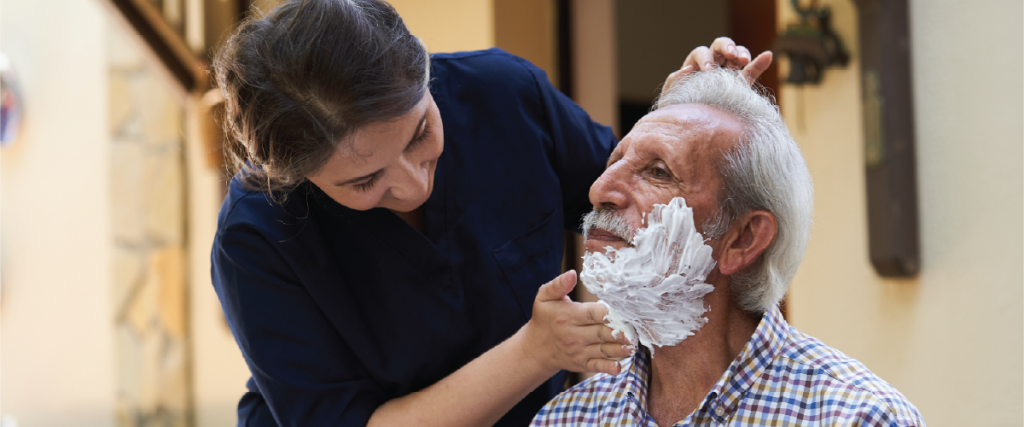
Caring for a family member or a close friend is one of the most important roles you will ever play. It may start by simply running errands, driving them to their doctor appointment or shopping. Later, you may find yourself handling their medications, meals, finances, activities of daily living or other medical complexities. Therefore, it is important to know your loved one’s healthcare preferences with a plan in place before a crisis occurs. Here are five important steps to help you through this caregiving journey.
Step One: Start the conversation – “I just read an article about gathering all your important papers. Sometime can you show me where yours are and what you’d like us to do just in case?” Be open, express your love and concern, most importantly listen, and respect your loved one’s wishes regarding home, health, finances, and legal needs. Include other trusted family members to be a part of the process.
Step Two: Form Your Team – Go deep and wide and decide who is in charge. Team members do not have to live nearby or have lots of time available to be useful. Family or friends can work behind the scenes with meal planning/organizing, chores, bill paying, and assistive technology solutions.
Step Three: Make a Plan – Keep the plan simple and include immediate and future needs. There are several roles’ people can help with; an assertive advocate to communicate with medical professionals or insurance companies; if your loved one wants to move, assign someone to research locations and facilities. Someone else might offer to spend some weekends sorting through their personal belongings.
Step Four: Find Support – A variety of services are available to people aged 60 and over and their caregivers and older relative caregivers 55 or older. This support can be found through your local area on aging. The Idaho Commission on Aging website https://aging.idaho.gov/stay-educated/caregiver-skills/ provides an array of Caregiver Skills videos sponsored by AARP’s Home Alone Alliance. Additionally,
- Hire Help – housekeeping, meal preparation, laundry, shopping, bathing
- Secure Safety – Handrails, grab bars, night-lights, adjustable shower seats
- Stay organized – Caregiving apps such as Caring Village and Medisafe
Step Five: Care for yourself – Exercise, maintain a healthy diet, and sleep. Overall, be sure to take time for activities you enjoy.
Resource: https://www.aarp.org/caregiving/basics/info-2019/first-time-caregiver-tips.html?intcmp=AE-CAR-CRC-LL (AARP, Family Caregiving Guide)
Visit the ICOA Website for Caregiver information
Contact your local Area Agency on Aging for programs and services
For free education on healthy caregiving topics visit the Idaho Commission on Aging’s Caregiving Education webpage.
Emergency Preparedness for Older Adults
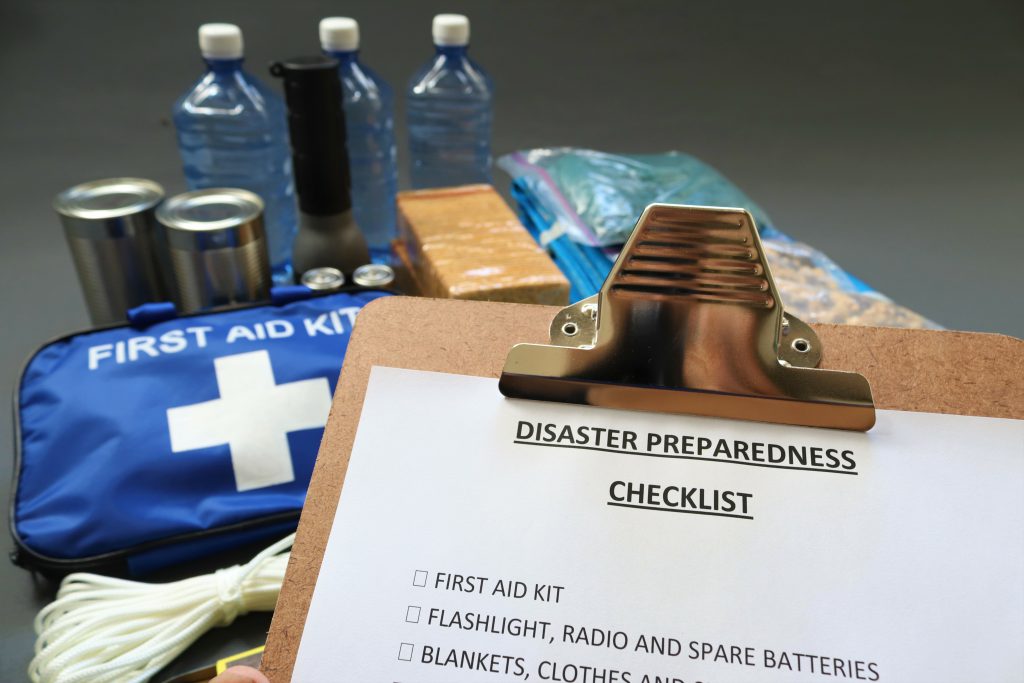
Follow these easy steps to make sure you’re protected.
Natural disasters, such as wildfires, floods, and blizzards, may force you to evacuate your home or shelter-in-place at short notice. It is important to know what to do in case of an emergency well before disaster strikes.
If you are an older adult living in the community, you may face some challenges during an emergency. For example, you may have mobility problems, or chronic health conditions, or you may not have any family or friends nearby to support you. Support services that are usually available, such as help from caregivers or in-home health care and meal delivery services, may be unavailable for a period of time. In addition, older adults may experience challenges that come with advanced age, such as hearing or vision problems or cognitive impairment, which may make it difficult to access, understand, and respond to emergency instructions.
You or the person you care for can be prepared for emergency situations by creating a plan, reviewing or practicing it regularly, and keeping an emergency supply kit.
Creating a Plan
The first step in preparing for an emergency is creating a plan. Work with your friends, family, and neighbors to develop a plan that will fit your needs.
- Choose a contact person who will check on you during a disaster, and decide how you will communicate with each other (for instance, by telephone, knocking on doors). Consider speaking with your neighbors about developing a check-in system together.
- Create a list of contact information for family members and friends. Leave a copy by your phone(s) and include one in your Emergency Supply Kit.
- Plan how you will leave and where you will go during an evacuation. If you are living in a retirement or assisted living community, learn what procedures are in place in case of emergencies. Keep a copy of exit routes and meeting places in an easy-to-reach place.
- Create a care plan and keep a copy in your Emergency Supply Kit. Try out the CDC’s easy-to-use care plan template.
- If you have medical, transportation, or other access needs during an emergency, consider signing up for SMART911, Code Red, or your local county registry, depending upon which service your area uses to helps first responders identify people who may need assistance right away.
Creating an Emergency Supply Kit
After an emergency, you may not have access to clean water or electricity. Make sure you are prepared with your own supply of food, water, and other items to last for at least 72 hours.
- Visit Ready.gov for a list of basic items to gather for your Disaster Supply Kit.
- Medical-Related Items:
- A 3-day supply of medicine, at a minimum. If medications need to be kept cold, have a cooler and ice packs available.
- ID band (full name, contact number for family member/caregiver, and allergies)
- Hearing aids and extra batteries
- Glasses and/or contacts and contact solution
- Medical supplies like syringes or extra batteries
- Information about medical devices such as wheelchairs, walkers, and oxygen including model numbers and vender.
- Documents (Keep physical copies in a waterproof bag and take photos of each document for backup):
- Contact information for family members, doctors, pharmacies and/or caregivers
- List of all medications, including the exact name of the medicine and the dosage, and contact information for pharmacy and doctor who prescribed medicine
- List of allergies to food or medicines
- Copies of medical insurance cards
- Copies of a photo ID
- Durable power of attorney and/or medical power of attorney documents, as appropriate.
Taking these steps will put you and/or your caregivers in a better position to deal with emergencies that may require you to evacuate or shelter in place. Contact your local Area Agency on Aging for information on senior services and resources in your area.
Elder Abuse Awareness
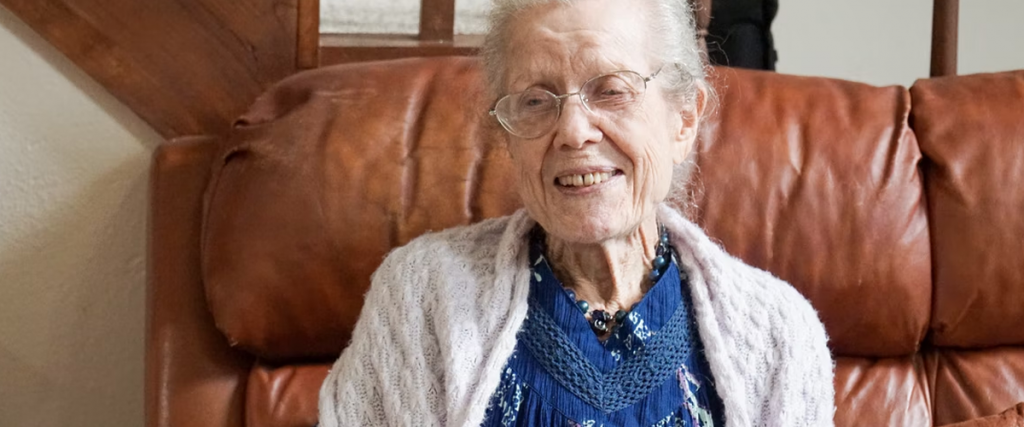

JUNE IS ELDER ABUSE AWARENESS MONTH
Throughout the month of June, the Idaho Commission on Aging, our statewide partners, and communities around the world will be working to raise awareness about adult abuse, neglect, and financial exploitation.
World Elder Abuse Awareness Day (WEAAD) was launched on June 15, 2006 by the International Network for the Prevention of Elder Abuse and the World Health Organization at the United Nations.
The purpose of WEAAD is to provide an opportunity for communities around the world to promote a better understanding of abuse and neglect of older people by raising awareness of the cultural, social, economic and demographic processes affecting elder abuse and neglect.
In addition, WEAAD is in support of the United Nations International Plan of Action acknowledging the significance of elder abuse as a public health and human rights issue. WEAAD serves as a call-to-action for society’s individuals, organizations, and communities to raise awareness about elder abuse, neglect, and exploitation.
How can you bring awareness?
This month promote elder abuse awareness within your networks and communities. Individual and community prevention efforts and supportive services help keep older adults safe and healthy, to help stop abuse before it happens.
Access the following information and ideas to help you reach as many individuals as possible.
Share on social media- include one or two recommended hashtags on your posts
- Sample Social Media Posts
- Elder abuse is a matter of worldwide concern that demands a global multifaceted response. Take action and be part of the solution. https://eldermistreatment.usc.edu/weaad-home #WEAAD #StopElderAbuse
- Elder abuse is an injustice with many consequences for our society, affecting everything from our communities’ public health to our economic resources. Working together, we can build the social supports that can prevent elder abuse. https://eldermistreatment.usc.edu/weaad-home #WEAAD
- June 15th is World Elder Abuse Awareness Day. Older people throughout the United States lose an estimated $2.6 billion or more annually due to elder financial abuse and exploitation. Elder abuse also creates health care and legal costs for our society. However, we can change this. Learn more: https://eldermistreatment.usc.edu/weaad-home #WEAAD
- We all deserve to lead happy and healthy lives free from abuse as we age, yet older people are mistreated more often than we think. Take action to raise awareness toward prevention on this important social justice issue! https://eldermistreatment.usc. edu/weaad-home #WEAAD #Volunteer
- Hashtags
- #ElderAbuseAwarenessMonth
- #WorldElderAbuseAwarenessDay
- #WEAAD
- #StopElderAbuse
- #ElderAbuse
- #FinancialAbuse
- #EveryonesBusiness
- #Volunteer
Wear purple clothing or a ribbon on June 15!
When someone asks you if purple has special meaning, start a conversation about elder abuse. It’s more common than you think, and rarely discussed socially.
Resources:
- Visit to the National Center on Elder Abuse website to increase your knowledge about elder abuse.
- Learn how you can decrease loneliness in older Idahoans with the Let’s End Loneliness Campaign in Idaho.
- Visit the ICOA website to learn about programs to keep vulnerable Idahoans safe.
Older Americans Month

Age My Way 2022
Older adults play vital, positive roles in our communities – as family members, friends, mentors, volunteers, civic leaders, members of the workforce, and more. Just as every person is unique, so too is how they age and how they choose to do it – and there is no “right” way. That’s why the theme for Older Americans Month (OAM) 2022 is Age My Way.
Every May, the Administration for Community Living (ACL) leads the celebration of OAM. This year’s theme focuses on how older adults can age in their communities, living independently for as long as possible and participating in ways they choose.
While Age My Way will look different for each person, here are common things everyone can consider:
- Planning:Think about what you will need and want in the future, from home and community-based services to community activities that interest you.
- Engagement: Remain involved and contribute to your community through work, volunteer, and/or civic participation opportunities.
- Access: Make home improvements and modifications, use assistive technologies, and customize supports to help you better age in place.
- Connection: Maintain social activities and relationships to combat social isolation and stay connected to your community.
Idaho includes a growing number of older Americans who contribute their strength, wisdom, and experience to our community.
Communities benefit when people of all ages, abilities, and backgrounds are welcomed, included, and supported.
The Idaho Commission on Aging (ICOA) recognizes our need to create a community that provides the services and supports older Americans need to thrive and live independently for as long as possible.
Idaho can work to build an even better community for our older residents by:
- Planning programs that encourage independence.
- Ensuring activities are responsive to individual needs and preferences.
- Increasing access to services that support aging in place.
This year, the Idaho Commission on Aging is excited to celebrate OAM with our partners in the aging community. Visit the ICOA website for more information on aging resources to help.
Please visit the Michigan Health website for information on “Want to “age in place” someday? Take Action Now” and learn 4 key tips on how to successfully “age in place”.
Diverse communities are strong communities. Ensuring that older adults remain involved and included in our communities for as long as possible benefits everyone. Please join the Idaho Commission on Aging in strengthening our community.
For more information, visit the official OAM website, follow ACL on Twitter and Facebook, and join the conversation using #OlderAmericansMonth.
Bounce Back from Difficult Times

6 Ways to Nurture Your Resilience
Everyone goes through tough times in life. But many things can help you survive—and even thrive—during stressful periods. Nurturing your body, brain, and social connections can help you bounce back from stress. Use the six strategies below to get you started!
Develop healthy physical habits. Healthy eating, physical activity, and regular sleep can improve your physical and mental health.
Take time for yourself. Make taking care of yourself part of your daily routine. Take time to notice the good moments or do something that you enjoy, like reading a book or listening to music.
Look at problems from different angles. Think of challenging situations as growth opportunities. Try to see the positive side of things. Learn from your mistakes and don’t dwell on them.
Practice gratitude. Take time to note things to be thankful for each day.
Explore your beliefs about the meaning and purpose of life. Think about how to guide your life by the principles that are important to you.
Tap into your social connections and community. Surround yourself with positive, healthy people. Ask friends, family, or trusted members of your community for information or assistance when you need it. Look for cultural practices that you feel help in times of stress.
Source: https://newsinhealth.nih.gov/2022/04/nurture-your-resilience
Humor is Healthy

Laughing is both a physical and mental stress reliever. A good laugh can soothe tension, aid in relaxation, and release feel-good hormones to your brain. Laughter has also been shown to strengthen a person’s immune system and help relieve pain by encouraging the body to release its own natural painkillers. Best of all, out of everything you can do for stress management, laughter takes the least amount of effort and planning. Don’t let a day go by without a moment of laughter!

Smile!
Smile at those around you. Smiling is the beginning of laughter, and like laughter, it’s contagious. Plus, a smile releases hormones in your brain to lower stress.

Ask
Make humor part of the conversation. Ask friends, family members, and co-workers, “What is the funniest thing that happened to you today?”

Laugh at Yourself
Share your embarrassing moments. The best way to take yourself less seriously is to talk about the times when you took yourself too seriously.

‘Kid’ Around
Notice how children play and try to emulate them. They are the experts on being silly, taking life lightly, and laughing at ordinary things.
Boost Your Budget

Millions of older adults are likely eligible for, but not enrolled in, benefits that can help them save money on health care, prescriptions, food, and more. Public benefit programs, such as the Supplemental Nutrition Assistance Program (SNAP), Medicaid, Medicare Savings Programs, and Part D Low-Income Subsidy, help these individuals save thousands of dollars each year by helping with the costs of food, health care, and prescriptions.
However, barriers to enrollment in these programs, i.e., knowledge of programs and how to apply, affect many eligible individuals from not receiving benefits that they need. That is why every April, the National Council on Aging (NCOA), along with its partner network, promotes Boost Your Budget® Week, a targeted campaign that aims to educate older adults about enrolling in public and private benefits that can save them money.
During the weeklong campaign, the aging and disability service network partners work to educate low-income Medicare beneficiaries and their caregivers about benefits available to improve health outcomes and economic security. Those participating in promoting the campaign are also encouraged to connect older adults with online and community resources for benefits screening and application assistance.
What is Boost Your Budget® Week?
Boost Your Budget® Week takes place each year during the second full week of April. This year, the campaign will run from April 11-15, 2022.
What can the aging and disability network partners do to promote Boost Your Budget® Week?
For any community, state, or private organization wanting to promote and be a part of the campaign, some of the things that you can do include:
- Share information about benefits as part of a food drive, health fair, or tax assistance event
- Run ads in local newspapers or on social media
- Invite media, legislators, and the public to tour your facility and learn about the importance of benefits for your community
- Posting information about the campaign on your website
- Educate your stakeholders (i.e., staff and clients) during meetings/presentations about Boost Your Budget® Week
What can YOU do to promote Boost Your Budget® Week?
Even if you do not work for an organization whose customers and clients are older adults, you can still do your part to spread the campaign message! Some activities that anyone can do to promote Boost Your Budget® Week can be:
- Share resources from NCOA’s toolkit about the campaign on your social media
- Let older adults in your family and social circle know about the campaign, and, if appropriate, let them know where they can find resources
- Craft a press release and send it to your local newspaper about the campaign
For further information and resources needed to start planning your Boost Your Budget® Week events, please visit the official Boost Your Budget® Week website.
Your efforts can be life changing for low-income seniors or people living with disabilities. Visit the ICOA website to learn more about the MIPPA/MSP programs.
National Kidney Month

March is National Kidney Month! Did you know 100,000 people are currently waiting for a kidney transplant?! With so few organs available for transplantation, living donation is the best way we have to continue to save lives. Living donation takes place when a living person donates an organ (or part of an organ) for transplantation to another person.
Transplanting organs from a living donor has the following benefits:
- The quality of organs that are donated by living donors is usually better than organs from deceased donors. These organs last nearly twice as long.
- The waiting time for a patient needing a transplant can be significantly shorter.
- The procedure can be scheduled at a time that’s convenient for both the donor and recipient.
- The time between removing the organ (or part of the organ) and transplanting it in the recipient is less.
- There is a lower chance of rejection. Also, the organ recipient will need fewer and lower doses of anti-rejection medication.
Living Kidney Donation
Complete a confidential questionnaire to see if you qualify to be a living donor.
 Official Government Website
Official Government Website
